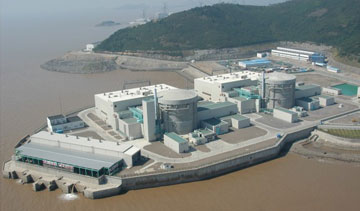
SNC signs nuclear deal to build Candu reactors with pair of Chinese companies
by Canadian Manufacturing.com Staff

Deal could breathe new life into Canadian nuclear industry, help eliminate coal power plants in China and beyond

China is no stranger to Candu reactor technology. The country’s Qinshan power plant operates two Candu 6 units, each capable of producing 728 MW of power. PHOTO Atomic Energy of Canada Ltd.
MONTREAL—The next generation of the Canadian-made Candu reactor is heading across the Pacific.
Canadian construction company SNC-Lavalin Inc. has inked an agreement in principle with China’s state-owned nuclear power agency and a major Chinese power company to finalize development on and build the Advanced Fuel Candu Reactor (AFCR).
SNC, which bought the rights for the Candu reactor in 2011, said the deal could be a “game-changer” for the nuclear industry and will bring new jobs to Canada.
Under the agreement, SNC, China National Nuclear Corporation (CNNC) and Shanghai Electric Group Company Ltd. will form a joint venture, which will then establish a pair of design centres in Canada and China to finish work on the AFCR reactor. The partnership could lead to the construction of the first AFCR reactor and possible future builds in China and beyond.
“This is a game changer in the nuclear industry, and a great endorsement of our expertise and CANDU nuclear technology from the largest nuclear market in the world,” Sandy Taylor, president of Power at SNC, said. “Each new build in China, and anywhere in the world, will benefit Canada in terms of job creation, innovation and nuclear research & development, environmental stewardship, and will contribute to reduce global carbon emissions.”
SNC expects to register the JV in mid-2017, though the deal is still subject to government and regulatory approvals.
Related: China aims to be global force in nuclear power technology
Touted as a “flexible fuel” reactor, if all moves forward as planned, the next-generation Candu design will use recycled fuel from light-water reactors (LWR) to produce electricity, instead of mined and enriched uranium. Along with eliminating the need for new sources of uranium, the reactor could take advantage of a readily-available resource produced at older nuclear plants. China, for instance, has 33 operating LWRs and another 23 under construction. No stranger to Candu technology, it also operates a pair of Candu 6 units at its nuclear plant in Qinshan. Each AFCR could operate solely on spent fuel from four light-water units.
As China and other countries worldwide work to eliminate coal-fired generation, the technology could also mitigate millions of tonnes of carbon dioxide annually.
Though it has been a tough several years for the nuclear industry since the 2011 Fukushima disaster in Japan, Canada’s home-grown Candu technology has been bolstered by recent Ontario investments. SNC says the new AFCR reactor incorporates a number of safety design enhancements stemming from lessons learned at Fukushima.